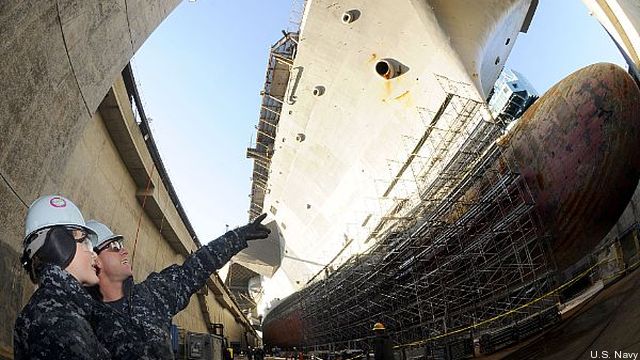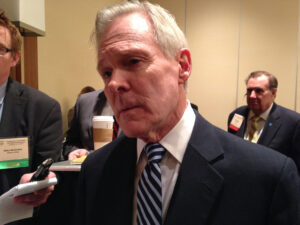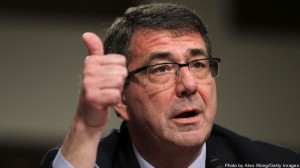Fix Readiness First, Shipbuilding Second: Navy To Trump
Posted on

Carrier USS Ronald Reagan in dry dock for maintenance.
WASHINGTON: Sure, the Navy needs more ships, but first and most urgently, it needs to fix the ships it already has. That’s what Navy leaders are telling Donald Trump.
“When the transition team came around to all of us in the building and asked us what we could do with more money right now, the answer was not to buy more ships,” Adm. William Moran, the Vice Chief of Naval Operations, told the Surface Navy Association yesterday afternoon. “The answer was to make sure the 274 we have were maintained to provide 274 ships’ worth of combat power. Then we’ll start buying more ships. They heard that loud and clear, I hope.”

Adm. William Moran, Vice Chief of Naval Operations
“The first thing we need to do is reinforce the foundation, which is our readiness, the maintenance of the ships we have today,” Moran said.
The Navy even has a specific figure for how much additional readiness money it needs to get its repair yards working at maximum capacity, although Moran wouldn’t disclose it. “We know precisely how much money we need in our readiness accounts to be able to execute the full magnitude of what our yards can handle for ship maintenance and modernization for ’17 and ’18. That number’s pretty well understood,” Moran said. “Any money that comes on top of that, we can start looking at how we would contract out for (new) ships (that) yards and contractors are ready to start building this year or next.”
So while readiness comes first, “that doesn’t mean we don’t need more ships. It’s all connected,” Moran emphasized. “Too small a Navy means we drive optempo (operational tempo) higher,” wearing out the fleet. Since 2001, the fleet has shrunk from 316 ships to 274, but high demand from commanders around the world means the number of ships deployed at any given time has stayed the same, so each ship is now deploying more. That pace increases wear and tear on both hulls and crews at the same time it decreases time to rest and refit. Over time, deferred maintenance leads to unexpected breakdowns that take ships out of service, forcing the rest of the fleet to work even harder.
More maintenance funding will slow down this vicious cycle in the short term, but in the long term the only solution is to buy more ships. Said Moran, “we need a bigger Navy so we can continue to meet demand without driving the current force, the smaller force, into the ground.”
Mabus Agrees – But….

Navy Sec. Ray Mabus
“Bill Moran and I have had this conversation,” Ray Mabus, the outgoing Navy Secretary, told reporters at a Defense Writers Group breakfast this morning. “I don’t think that it’s an either/or here. One of the readiness problems that we do have is we don’t have enough ships.” Cutting shipbuilding budgets to fund near-term readiness just makes the problem worse in the long term, he warned repeatedly.
But if you’re adding dollars to the Navy budget, as Trump has pledged, Mabus went on, then yes, the next dollar needs to go to maintenance, not shipbuilding. “[For] the very close in of the ’18, ’19, budget, (given) the shipbuilding plan that we were on, if you’ll stick to that, then … take those marginal dollars and put them into today’s readiness.”
That’s a remarkable admission from Mabus. The Navy Secretary prides himself on building more ships than his predecessors: 86 ships put under contract during his eight-year term, versus 41 in the previous seven, as he says at every opportunity. Mabus even got into a public fight with Defense Secretary Ashton Carter over shipbuilding funds in the 2018-2022 budget plan.

Ashton Carter
“We were ordered to cut $16 billion and instead I added $35,” Mabus said with satisfaction. (Carter & co. have told the Navy to spend less on new ships and more on upgrading the ships it has with modern weapons). Since the 2018 plan will be finalized and submitted by the Trump administration, which has promised much higher funding for defense, Mabus considered Carter’s cuts “a useless exercise,” he said bluntly. “This was at best symbolic, and if you’re going to put in a symbolic budget,” he said, why not lay out what the Navy really needs? “To say, nah, fewer ships, just makes no sense,” Mabus said, “and it undercuts one of the central requirements of this administration.”
“The ships that I put under contract will get us to 308 ships by 2021,” said Mabus, but, he emphasized, that’s the Navy’s old goal, calculated in 2012, before Russia seized Crimea or China built artificial islands in the South China Sea. The new Force Structure Assessment just completed calls for 355.
That’s almost exactly the figure Trump called for in the campaign, 350 ships. Some skeptics call the closeness suspiciously “convenient,” said Adm. Moran, but “I assure you our analysis has been going on for more than a year.” It also lines up with older studies that called for a fleet in the “mid-300s” and with three independent studies ongoing of fleet architecture, he said: “All three of those, independently, without any collaboration or guidance from OPNAV (Navy HQ) staff, came up with roughly the same number.”
Getting consensus on 355 ships is a good start, but getting funding for 355 ships will be much harder, Moran warned: “We can’t get overly excited about the potential for that much money coming our way.”
Subscribe to our newsletter
Promotions, new products and sales. Directly to your inbox.
